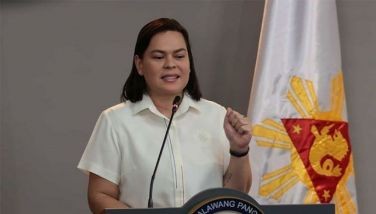Memories are made of these
May 12, 2002 | 12:00am
Greeting cards don’t cost much, but for Lucila Alamazan they are a treasured collection. And a priceless source of beautiful memories.
If you’re in your seventies, like Lucila and her doctor-husband Nestor, beautiful memories make the world go around. Maybe not as fast as in their younger days, but it’s whirling nonetheless, even throwing them quite recently into a brief spin of fame.
During the last great to-do for Valentine’s Day in this amorous city, a Valentine’s card sent by Nestor to Lucila, or Ising as he affectionately calls her, won a Hallmark Card contest for the sweetest, most sincere and loving dedication. Imagine the couple’s surprise when they found themselves the apple of the media eye, photographed, interviewed and written about, as if the world suddenly discovered they held the secret to endless love. Then again, maybe they did.
It was great while it lasted and they savored their 15 minutes in the spotlight with their children and grandchildren who adore them and their friends and neighbors who admire them. And when the sparkle of fame faded away, they let out a sign of relief and settled down once more to the quiet but not exactly uneventful day-to-day life, by the grace of God, in their house in Biñan, Laguna.
The good doctor, relegated to a wheelchair after two disabling strokes, spends most of the day in his room listening to the news on radio and cable TV. When he stirs, it is to pray (once an ardently evangelical Cursillista, he’s now an avid, if chair-bound, follower of El Shaddai) or to ask for a plate of his favorite carbonara which, in the days before his first stroke in 1994, he devoured by the pan.
His wife loves nothing more than to cook carbonara and her other well-liked dishes, careful always with the salt and the oil, as she herself is cautiously watching her diet. Ising was a principal at the La Concordia College in Manila before she was enjoined by her parents (she’s their only child) to take over the family’s hardware store, the first in Biñan, set up by her father in the early ’30s, during the "peacetime" era before the Pacific war. In business she was hard as nails–pardon the pun–but deep inside she was a hopeless, quivering romantic.
Ising has kept all the cards her husband has ever sent her, one for every significant occasion since 1949, when he gave her a Christmas card. It was, curiously, a Hallmark card. Apparently in those days, Hallmark cards were brought into the country by traders who knew they would sell well in the stores. It was not until 1974 that National Book Store got the official distribution rights to Hallmark cards and popularized the idea of "no one throws a Hallmark card away...no one throws away memories."
I sing Almazan understood the evocative power of greeting cards long before Richard Tann sang that Hallmark song (now being played on radio again, as touching and melodious ever). Through these cards she has marked the passage of the years and at the same time she has measured the breadth and depth of her husband’s love for her up through the time when, for most elderly couples, the bloom of romance and sentimentality has long withered on the vine.
She holds dear the very first Valentine card Nestor gave her in 1951, the year they married in church after a "secret wedding" before the judge, a customary practice during their time. The card reads, in squirmingly delicious doggerel: "Dear Ising/Among the dearest treasures/Recorded in my heart/The happiness you’ve brought to me/Stands precious and apart/And nothing I might say, Sweetheart/And nothing I might do/Could quite convey the love I feel/Deep in my heart for you."
The greeting cards in those days were big, measuring as much as 10" X 8", in special thick paper, embossed, padded or die-cut, and with the cutest designs. The doctor remembers buying them in a bookstore in Sta. Cruz but can not now be sure of the name of the store. The more expensive cards, he says, cost as much as P4.50 or P5–in those days nearer to the dinosaur than to Shrek as far as today’s youngsters are concerned. And the cards came individually packed in nice and sturdy boxes.
He has since given her a card, without fail, every Valentine’s and Christmas, on her birthday and, in more recent years, on Mother’s Day, often with dedications he himself composed in his own neat script (very unusual for doctors whose prescriptions are thoroughly illegible). "It’s my way of showing how much I love my wife, " says the doctor. He describes Ising as "subok na matibay, subok na matapat".
Nestor believes that the greeting cards signify for them good luck and the good things in life. He strongly feels that if he changed the gift giving from cards to something like, say, jewelry or perfume, something bad might befall them.
Ising for her part has carefully preserved all of his cards in a huge thick album that has grown to two volumes–and is still growing. The latest card she got from him was on Feb. 14, 2002, which reads: "Ising, Whatever happens please remember that you are and always will be my only Valentine till the end of time. Nestor."
"Till the End of Time," popularized by Perry Como, is their theme song. "I hope they will play that song when the time comes..." says Nestor wistfully.
If you’re in your seventies, like Lucila and her doctor-husband Nestor, beautiful memories make the world go around. Maybe not as fast as in their younger days, but it’s whirling nonetheless, even throwing them quite recently into a brief spin of fame.
During the last great to-do for Valentine’s Day in this amorous city, a Valentine’s card sent by Nestor to Lucila, or Ising as he affectionately calls her, won a Hallmark Card contest for the sweetest, most sincere and loving dedication. Imagine the couple’s surprise when they found themselves the apple of the media eye, photographed, interviewed and written about, as if the world suddenly discovered they held the secret to endless love. Then again, maybe they did.
It was great while it lasted and they savored their 15 minutes in the spotlight with their children and grandchildren who adore them and their friends and neighbors who admire them. And when the sparkle of fame faded away, they let out a sign of relief and settled down once more to the quiet but not exactly uneventful day-to-day life, by the grace of God, in their house in Biñan, Laguna.
The good doctor, relegated to a wheelchair after two disabling strokes, spends most of the day in his room listening to the news on radio and cable TV. When he stirs, it is to pray (once an ardently evangelical Cursillista, he’s now an avid, if chair-bound, follower of El Shaddai) or to ask for a plate of his favorite carbonara which, in the days before his first stroke in 1994, he devoured by the pan.
His wife loves nothing more than to cook carbonara and her other well-liked dishes, careful always with the salt and the oil, as she herself is cautiously watching her diet. Ising was a principal at the La Concordia College in Manila before she was enjoined by her parents (she’s their only child) to take over the family’s hardware store, the first in Biñan, set up by her father in the early ’30s, during the "peacetime" era before the Pacific war. In business she was hard as nails–pardon the pun–but deep inside she was a hopeless, quivering romantic.
Ising has kept all the cards her husband has ever sent her, one for every significant occasion since 1949, when he gave her a Christmas card. It was, curiously, a Hallmark card. Apparently in those days, Hallmark cards were brought into the country by traders who knew they would sell well in the stores. It was not until 1974 that National Book Store got the official distribution rights to Hallmark cards and popularized the idea of "no one throws a Hallmark card away...no one throws away memories."
I sing Almazan understood the evocative power of greeting cards long before Richard Tann sang that Hallmark song (now being played on radio again, as touching and melodious ever). Through these cards she has marked the passage of the years and at the same time she has measured the breadth and depth of her husband’s love for her up through the time when, for most elderly couples, the bloom of romance and sentimentality has long withered on the vine.
She holds dear the very first Valentine card Nestor gave her in 1951, the year they married in church after a "secret wedding" before the judge, a customary practice during their time. The card reads, in squirmingly delicious doggerel: "Dear Ising/Among the dearest treasures/Recorded in my heart/The happiness you’ve brought to me/Stands precious and apart/And nothing I might say, Sweetheart/And nothing I might do/Could quite convey the love I feel/Deep in my heart for you."
The greeting cards in those days were big, measuring as much as 10" X 8", in special thick paper, embossed, padded or die-cut, and with the cutest designs. The doctor remembers buying them in a bookstore in Sta. Cruz but can not now be sure of the name of the store. The more expensive cards, he says, cost as much as P4.50 or P5–in those days nearer to the dinosaur than to Shrek as far as today’s youngsters are concerned. And the cards came individually packed in nice and sturdy boxes.
He has since given her a card, without fail, every Valentine’s and Christmas, on her birthday and, in more recent years, on Mother’s Day, often with dedications he himself composed in his own neat script (very unusual for doctors whose prescriptions are thoroughly illegible). "It’s my way of showing how much I love my wife, " says the doctor. He describes Ising as "subok na matibay, subok na matapat".
Nestor believes that the greeting cards signify for them good luck and the good things in life. He strongly feels that if he changed the gift giving from cards to something like, say, jewelry or perfume, something bad might befall them.
Ising for her part has carefully preserved all of his cards in a huge thick album that has grown to two volumes–and is still growing. The latest card she got from him was on Feb. 14, 2002, which reads: "Ising, Whatever happens please remember that you are and always will be my only Valentine till the end of time. Nestor."
"Till the End of Time," popularized by Perry Como, is their theme song. "I hope they will play that song when the time comes..." says Nestor wistfully.
BrandSpace Articles
<
>
- Latest
- Trending
Trending
Latest
Trending
Latest
Recommended



















